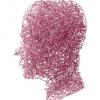I regret I am reading the wikipedia page and finding no mention of anything other than dopamine. The same wiki page even says this about dopamine itself interacting with other NTs (including GABA and glutamate),
"Dopamine (DA) is a neurotransmitter in the brain, which controls feelings of wellbeing. This sensation results from the interaction of dopamine and other neurotransmitters such as serotonin, the opioids, and other brain chemicals. Dopamine increases the motivation for food cravings and appetite mediation.[12]"
Plenty of things will be knocked down with D2: FosB, addiction, suicidality, BDNF, Akt, pi3k, and cAMP to name a few. But whatever you may say it remains the case that there is little evidence to suggest the involvement of other neurotransmitters. In particular, for serotonin, there is a pronounced delineation of symptoms (except that carriers of one are likelier to carry both):
"Our findings support the hypotheses that the 5-HTTLPR S allele may predispose to (performance) anxiety, while DRD2 Taq1 ANKK1 allele may predispose to the reward deficiency syndrome."
Since a carrier of one is likely to carry both, we see in this article, ANKK1 is also significantly associated to anxiety. Moreover, everything in the research suggests ANKK1 just causes problems at dopamine sites... so by addressing that symptom (dopamine), you address 90% of the problem. There are different ways of doing this but red ginseng is a cheap one.
Neurotox Res. 2016 Apr;29(3):345-50. doi: 10.1007/s12640-015-9545-9. Epub 2015 Jul 21.
The Addiction-Related Gene Ankk1 is Oppositely Regulated by D1R- and D2R-Like Dopamine Receptors.
Ponce G1,2, Quiñones-Lombraña A1,3, Martín-Palanco NG1,3, Rubio-Solsona E4, Jiménez-Arriero MÁ1,3, Palomo T1,3, Hoenicka J5,6,7.
Abstract
The ankyrin repeat and kinase domain containing 1 (ANKK1) TaqIA polymorphism has been extensively studied as a marker of the gene for dopamine receptor D2 (DRD2) in addictions and other dopamine-associated traits. In vitro mRNA and protein studies have shown a potential connection between ANKK1 and the dopaminergic system functioning. Here, we have investigated whether Ankk1 expression in the brain is regulated by treatment with dopaminergic agonists. We used quantitative RT-PCR of total brain and Western blots of specific brain areas to study Ankk1 in murine brain after dopaminergic treatments. We found that Ankk1 mRNA was upregulated after activation of D1R-like dopamine receptors with SKF38393 (2.660 ± 1.035-fold; t: 4.066, df: 11, P = 0.002) and apomorphine (2.043 ± 0.595-fold; t: 3.782, df: 8, P = 0.005). The D2R-like agonist quinelorane has no effect upon Ankk1 mRNA (1.004 ± 0.580-fold; t: 0.015, df: 10, P = 0.9885). In contrast, mice treatment with the D2R-like agonists 7-OH-DPAT and aripiprazole caused a significant Ankk1 mRNA downregulation (0.606 ± 0.057-fold; t: 2.786, df: 10, P = 0.02 and 0.588 ± 0.130-fold; t: 2.394, df: 11, P = 0.036, respectively). With respect the Ankk1 proteins profile, no effects were found after SKF38393 (t: 0.54, df: 2, P = 0.643) and Quinelorane (t: 0.286, df: 8, P = 0.782) treatments. In contrast, the D2R-like agonist 7-OH-DPAT (±) caused a significant increment of Ankk1 in the striatum (t: 2.718, df: 7; P = 0.03) when compared to the prefrontal cortex. The activation of D1R-like and D2-R-like leads to opposite transcriptional regulation of Ankk1 by specific pathways.
J Ginseng Res. 2014 Oct 15; 38(4): 256–263.
Korean Red Ginseng attenuates anxiety-like behavior during ethanol withdrawal in rats
ZhengLin Zhao,1,2,☆ Young Woo Kim,2,☆ YiYan Wu,1Jie Zhang,1Ju-Hee Lee,2XiaoHua Li,1Il Je Cho,2Sang Mi Park,2Dae Hwa Jung,2Chae Ha Yang,2Sang Chan Kim,2,∗ and RongJie Zhao1,2,∗∗
Abstract
Background
Korean Red Ginseng (KRG) is known to have antianxiety properties. This study was conducted to investigate the anxiolytic effects of KRG extract (KRGE) during ethanol withdrawal (EW) and the involvement of the mesoamygdaloid dopamine (DA) system in it.
Methods
Rats were treated with 3 g/kg/d of ethanol for 28 d, and subjected to 3 d of withdrawal. During EW, KRGE (20 mg/kg/d or 60 mg/kg/d, p.o.) was given to rats once/d for 3 d. Thirty min after the final dose of KRGE, anxiety-like behavior was evaluated in an elevated plus maze (EPM), and plasma corticosterone (CORT) levels were determined by a radioimmunoassay (RIA). In addition, concentrations of DA and 3,4-dihydroxyphenylacetic acid (DOPAC) in the central nucleus of the amygdala (CeA) were also measured by high performance liquid chromatography (HPLC).
Results
The EPM test and RIA revealed KRGE inhibited anxiety-like behavior and the over secretion of plasma CORT during EW. Furthermore, the behavioral effect was blocked by a selective DA D2 receptor (D2R) antagonist (eticlopride) but not by a selective DA D1 receptor (D1R) antagonist (SCH23390). HPLC analyses showed KRGE reversed EW-induced decreases of DA and DOPAC in a dose-dependent way. Additionally, Western blotting and real-time polymerase chain reaction (PCR) assays showed that KRGE prevented the EW-induced reductions in tyrosine hydroxylase (TH) protein expression in the CeA and TH mRNA expression in the ventral tegmental area (VTA).
Conclusion
These results suggest that KRGE has anxiolytic effects during EW by improving the mesoamygdaloid DA system.
Int J Neuropsychopharmacol. 2013 Oct; 16(9): 2095–2101.
DRD2/ANKK1 Taq1A polymorphism (rs1800497) has opposing effects on D2/3 receptor binding in healthy controls and patients with major depressive disorder
Jonathan Savitz,1,2,3Colin A. Hodgkinson,4Chantal Martin-Soelch,5Pei-Hong Shen,4Joanna Szczepanik,3Allison C. Nugent,6Peter Herscovitch,7Anthony A. Grace,8David Goldman,4 and Wayne C. Drevets1,3,9
Abstract
The A1 allele of the DRD2/ANKK1 Taq1A polymorphism (rs1800497) is associated with reduced striatal D2/3 receptor binding in healthy individuals (Con) as well as depression and addiction. However, the effect of rs1800497 on D2/3 receptor binding in depressed patients as well as the SNP’s effect on D2/3 binding during reward-associated dopamine release is unknown. Twelve unmedicated patients with major depressive disorder (MDD) and 24 Con completed PET scans with [11C]raclopride, once without receiving monetary rewards (baseline) and once while winning money. In Con, the A1 allele was associated with reduced baseline binding potential (BPND) in the middle caudate and ventral striatum. However, in MDD patients the A1 allele was associated with increased baseline BPND in these regions. There were no significant associations between rs1800497 and change in BPND during reward-associated dopamine release. Conceivably, the A1 allele predisposes to depression and addiction via its effect on the post-synaptic D2 receptor.
Introduction
The majority of dopamine (DA) D2 receptors are densely distributed on post-synaptic, non-dopaminergic neurons in the striatum where D2 signalling modulates a variety of functional domains, including reward processing and appetitive behaviour. Additionally, D2 autoreceptors located in the somas, dendrites and terminals of DA neurons in the ventral tegmentum negatively regulate DA signalling by modulating firing rate (Ford et al., 2010), and DA release and synthesis (Wolf and Roth, 1990), respectively. A widely studied single nucleotide polymorphism (SNP), the so-called DRD2/ANKK1 Taq1A polymorphism (rs1800497, Glu713Lys) is located ~10 kb downstream from the DRD2 gene in the ankyrin repeat and kinase domain containing 1 (ANKK1) gene.
The A1 allele of rs1800497 has consistently been implicated in addiction disorders (Noble, 2000; Smith et al., 2008; Chen et al., 2011) and has also been reported to be a risk factor for depression, possibly via its impact on the quality of early parental interactions. Mills-Koonce et al. (2007) reported that children with the A1 allele showed more negative emotions during interactions with their parents, an effect that was attenuated by maternal sensitivity. Consistent with these data, the A1 allele was associated with ‘social problems’ as measured by the Child Behaviour Checklist questionnaire in children with reading disorders (Marino et al., 2004). In another study the A1 allele was associated with emerging symptoms of anxiety and depression as well as parent× child interactions characterized by negative emotions (Hayden et al., 2010). Similarly, children aged 10–12 yr with the A1 allele were more sensitive to negative feedback during a probabilistic learning task (Althaus et al., 2009). The putative effect of the A1 allele on childhood behaviour and depression may arise from basic physiological differences in the ability to regulate emotions that are present very early in development. Infants aged 3 and 6 months with the A1 allele, who were separated from their parents in an experimental setting, showed reduced ability to regulate vagal tone compared to infants without an A1 allele (Propper et al., 2008). In a longitudinal study of 2347 adult males, the A1 allele was associated with an increased risk of developing depressive symptoms at follow-up (odds ratio 2.55; Roetker et al., 2012). Consistent with these data, veterans with post-traumatic stress disorder who carried the A1 allele had more symptoms of anxiety, depression and social dysfunction than A2/A2 homozygotes (Lawford et al., 2006).
The Taq1A polymorphism or a variant in linkage disequilibrium with Taq1A appears to affect D2 receptor binding, perhaps explaining the reported associations between Taq1A and psychiatric and addiction disorders. Relative to the A2 allele, the A1 allele has been associated with reduced striatal glucose metabolism (Noble et al., 1997) and reduced binding of the D2/3 receptor antagonist, [11C]raclopride, in studies of healthy subjects (Thompson et al., 1997; Pohjalainen et al., 1998; Jonsson et al., 1999). In addition, the DRD2 C957T SNP, which may be in linkage disequilibrium (LD) with rs1800497 (Hirvonen et al., 2009), reportedly affects striatal D2/3 receptor binding in healthy volunteers (Hirvonen et al., 2004).
Although genetic studies have implicated the TaqA1 allele in susceptibility to depression and the TaqA1 allele has been associated with reduced D2 receptor binding in healthy controls, it is unknown how the TaqA1 allele would affect D2 receptor binding in patients with mood disorders. As we reported in our recent review of the positron emission tomography (PET) D2 literature, the data are contradictory and arguably the weight of data is suggestive of increased D2 receptor binding in mood disorders (Savitz and Drevets, 2013). For example, compared with healthy controls, unmedicated patients with major depressive disorder (MDD) and motor retardation displayed increased [11C]raclopride binding potential (BPND) in the caudate and striatum (Meyer et al., 2006) and Kestler et al. (2000) reported a positive correlation between [11C]raclopride binding in the striatum and the ‘depression’ subscale score of the NEO Personality Inventory. Similarly, an increase in striatal D2 receptor binding in depression was reported in single photon emission tomography studies using the radioligand, 123I-iodobenzamide (D’Haenen and Bossuyt, 1994; Shah et al., 1997). Potentially consistent with these data, rats exposed to chronic social stress display elevated D2 receptor binding in the striatum (Lucas et al., 2004); although see (Zhu et al., 2011) who report decreased stress-associated D2 mRNA expression in the striatum. Nevertheless, it is conceivable that the elevations of D2 receptor availability and increased [11C]raclopride binding observed in depressed humans and in rodent depression analogues may arise secondarily to reductions in baseline DA release, consistent with the decreased basal firing activity of DA neurons in rats studied in depression models (Chang and Grace, 2012).
In order to investigate the apparent contradiction between the genetic association studies that implicate the A1 allele in depression, and some of the in vivo human and animal studies that are suggestive of increased D2 receptor binding in MDD or rodent analogues thereof, we measured the effect of the Taq1A SNP on D2 receptor BPND in both healthy volunteers and unmedicated patients with MDD.
Furthermore, in contrast to previous studies that measured the effect of the Taq1A SNP on D2 receptor binding at rest only (i.e. during tonic DA release), we also tested the effect of the Taq1A SNP on D2 receptor BPND during receipt of unpredicted reward (i.e. during phasic DA release). We were able to do this by scanning subjects under two conditions during PET[11C]raclopride imaging. In the first condition the subjects played a slot machine task without receiving monetary rewards (baseline condition) and in the second, subjects received unpredictable monetary rewards while performing the identical slot machine task (reward condition). This approach yielded two measures of striatal DA transmission: (1) D2/3 receptor BPND in the striatum at baseline; (2) the effect of endogenous DA released from DA neurons, measured as the percentage decrease in [11C]raclopride BPND between baseline and reward PET images (ΔBPND).























































